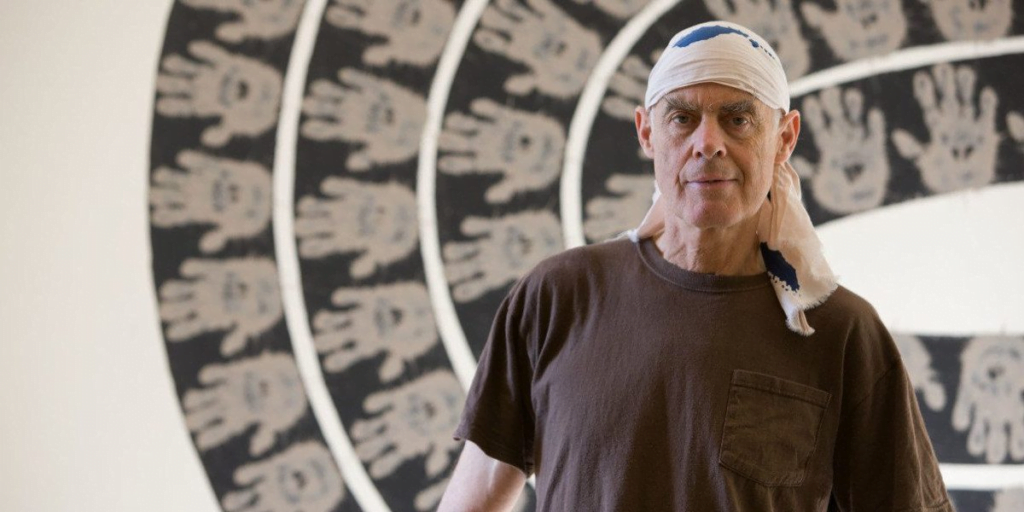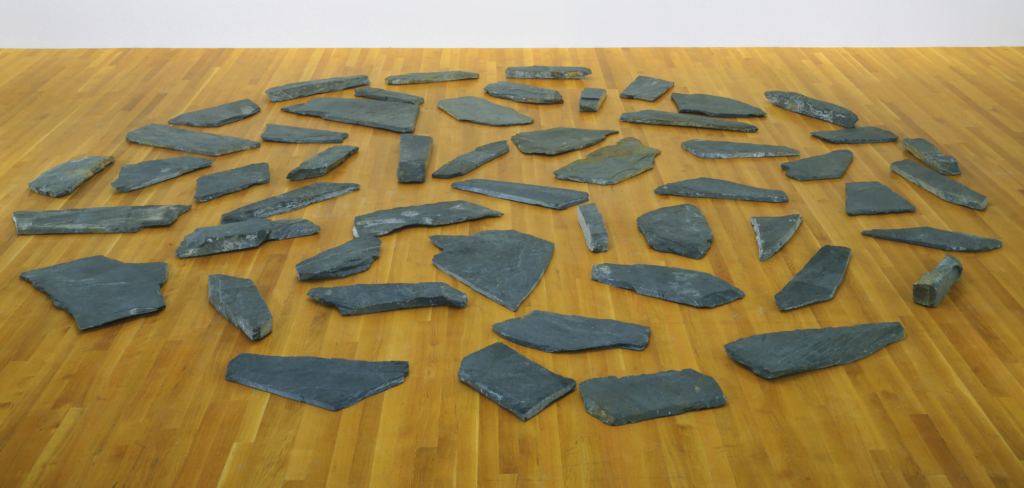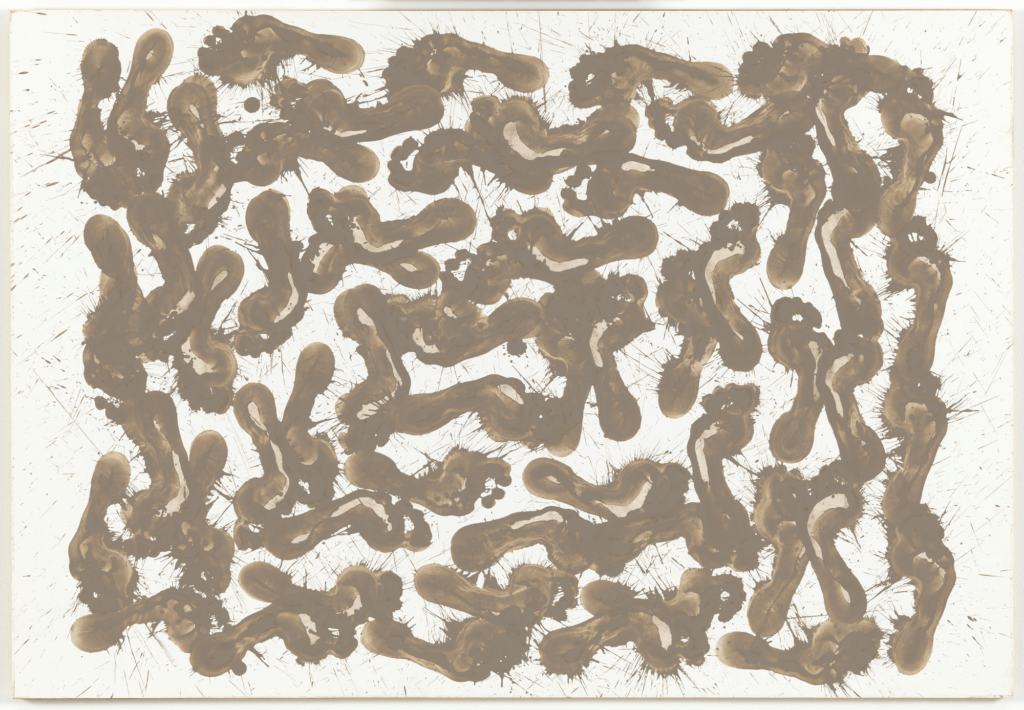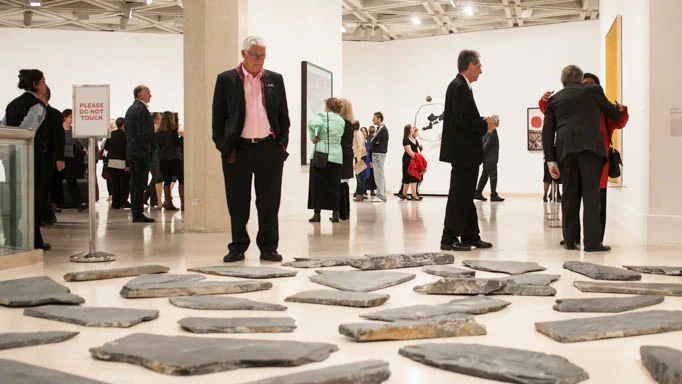Memoriesforart » Artists » Richard Long
More Facts
Name: Richard
Surname: Long
Lives & Works: Bristol
Lives in State: South West
Nationality: England
Date of Birth: 1945
Period: Post-War
Movement: Contemporary art, Land Art
Table of Contents
As you embark on a journey through the life and art of Richard Long, prepare to traverse the English countryside and span the globe. Long’s art mirrors his passion for walking and exploring natural landscapes. Through his walks, Long creates simple but poetic sculptures and photographs that glimpse humanity’s connection with the earth.
Raised in Bristol, Long developed an early love of walking during family holidays in Exmoor. He channelled this passion into his art, pioneering a new genre that fused sculpture, photography, and performance. Long’s art emphasizes simplicity, physicality, and a reverence for nature. His walks have taken him through remote forests, mountain ranges, and deserts worldwide.
Over 50 years, Long has become Britain’s preeminent landscape artist. His art reminds us of walking’s ability to inspire, ground us, and reconnect us with the world around us. The story of Long’s life is one of a man shaped by the simple act of putting one foot in front of the other. Through his art, we glimpse the beauty and solace he has found along the trail. Join the journey and discover what lies around the bend.

Richard Long was born in Bristol, England in 1945. His father worked as a cabinetmaker, and his mother as a shorthand typist. Long grew up in a working-class family and attended Fairfield Grammar School, showing an early aptitude for art.
After finishing secondary school, Long enrolled at the West of England College of Art, where he studied under abstract painter John Hoyland. Hoyland encouraged Long to push the boundaries of traditional painting.
Long began incorporating natural materials like leaves, mud, and sticks into his artwork. He started creating site-specific installations and land art, beginning his exploration of themes connecting nature, walking, and art.
After graduating in 1966, Long travelled extensively, visiting Italy, Switzerland, and New York. These travels exposed him to new artistic styles and inspired his vision of creating art from ephemeral, natural materials found in the environment. Long was mainly influenced by the Arte Povera movement in Italy, which incorporated humble, everyday materials into art.
Upon returning to England, Long moved to London and held his first solo exhibition at the Konrad Fischer Gallery in 1968, featuring his signature mud works and line drawings. This exhibition established his place as a pioneering land artist in the British art scene. Long’s artistic style and philosophy were clearly defined, focusing on simplicity, walking, and a deep connection with nature. His walks became a crucial part of his creative process, shaping his life and art.

Richard Long is a renowned British artist known for his land art and sculpture. Through his sculptures, walks, and installations, Long has explored man’s connection to nature and place, reminding us of the poetic possibilities in the everyday.
His pioneering land art has shaped contemporary environmental art and challenged traditional understandings of artistic practice. Long’s revolutionary vision and masterful use of humble materials have established him as a seminal figure in 20th-century art.

In the late 1960s, Long began combining walking with art, using walking to make ‘sculpture.’ During long treks through rural landscapes, he would make simple interventions using stones, sticks and other natural materials. Photographs of these ephemeral works were his only record and art object. This pioneering work influenced later generations of walking artists and sculptors.
One of his notable sculptures is “A Line Made by Walking,” created in 1967. This piece consists of a straight line produced by walking back and forth in a grass field, leaving a flattened path in its wake.
The simplicity and minimalism of this sculpture reflect Long’s interest in the relationship between humans and the natural environment. By using his own body to create art, Long blurs the boundaries between art and nature, inviting viewers to contemplate their connection to the world around them.
In the 1970s, Long began creating site-specific installations in natural landscapes using local materials like stones, mud and twigs. He began arranging these materials, often in circular forms, along paths or secluded clearings in forests or mountainsides. The materials remained on site, eventually dispersing back into the environment. These works explored the relationship between art and nature, impermanence versus permanence.
Long’s minimalist and temporary works, made from natural materials and shaped by walking through landscapes, shaped the development of land art. His pioneering vision and harmonious fusing of art and environment have inspired generations of artists. Through simple but poetic gestures, Long reveals the beauty in nature and awakens us to our connection with the world around us.
Sculptor
Painter

Richard Long has had an illustrious career spanning over 50 years. Some of his most famous projects and exhibitions demonstrate his artistic range and vision.
|
1988 |
Sahara Line |
Long walked a straight line in the Sahara Desert, displacing stones to create a sculpture that stretched over 15 miles. This ambitious land art piece epitomizes Long’s minimalist yet monumental approach. |
|
2009 |
A Thousand Miles, A Thousand Years |
For this solo exhibition, Long gathered materials from a 1,000 mile walk through rural England to create site-specific mud wall paintings and stone installations. The organic materials and elemental forms were arranged in geometric patterns that evoked a sense of continuity between man and nature, past and present. |
|
2012 |
“Richard Long: A Line Made by Walking” |
Exhibition at the Dia Art Foundation introduced Long’s pioneering work to new generations of artists and nature enthusiasts. |
|
2013 |
Several Circles |
Long returned to his roots for this outdoor installation at South Downs National Park in southern England. He arranged slabs of Purbeck marble in a series of concentric circles, reminiscent of an ancient stone circle monument. The simple yet striking piece fused contemporary art with the prehistoric landscape, exploring concepts of cycle, infinity and man’s connection with the earth. |
Long has received significant critical acclaim and recognition for his pioneering work.
He was awarded in 1989 the Turner Prize, the UK’s most prestigious visual art award.
His sculptures and installations are found in significant museum collections worldwide, including:
The Tate
Guggenheim
Museum of Modern Art
Long’s understated, environmentally-conscious pieces made from stones, mud, and wood in remote natural settings contrast with the monumental land art of contemporaries like Robert Smithson. However, like Smithson and others, Long’s work sought to push the boundaries of sculpture and reframe how we understand our relationship with the land.
Through his walks, maps, and stone sculptures, Richard Long forged a new way of connecting art and the environment that shaped land art in the 20th century and continues to inspire today. His minimal and poetic work reminds us that we can find meaning and art wherever we wander if we open our senses to the landscape.
Many things inspire Richard Long, but one of the most significant influences on his work is his deep connection with the natural world. Long often takes long walks in remote landscapes, documenting his journeys through photographs, maps, and text.
These experiences in nature inspire him to create his art, using natural materials like stones, sticks, and mud to create sculptures and installations that reflect his interactions with the environment. Richard Long’s work also draws inspiration from the history and traditions of land art and other artists who explore similar themes.